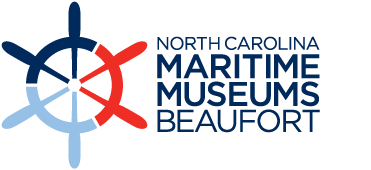07 Nov NaviLens technology empowers Blind visitors
Maritime Museum the first in the U.S. to introduce use of accessibility feature
New technology that assists Blind and low-vision visitors in navigating the museum autonomously is now available in our gallery.
The project is a first for any museum in the United States.
“I am not aware of anyone using NaviLens to enhance accessibility in the same way we’re applying NaviLens here,” Museum Volunteer Peter Crumley said.
Crumley, who is Blind, was instrumental in bringing the NaviLens technology to the museum. He was already familiar with its use in Spain and by the New York Metropolitan Transportation Authority to provide scheduling and general transit information along targeted system lines, as well as by the Kellogg Company to assist shoppers. But Crumley envisioned additional uses for NaviLens and even helped secure funding from the Beaufort Lions Club to help cover the associated costs with bringing it to the museum.
“There are so many potential applications for this technology, it’s unreal,” Crumley said.
NaviLens uses unique colored blocks that can be scanned by using the related app on a mobile device, much as QR codes are accessed. Unlike QR codes, however, the NaviLens codes are detected automatically by the phone camera in use by those moving with the NaviLens app open on their phone. Those codes, or tags, can also be read from a distance; and multiple tags can be detected simultaneously. The app can then help users navigate through the museum space by audibly narrating the associated information and through audible directional prompting. The tags also include an overview of a specific exhibit or museum space, as well as description of the artifacts on display. Museum Associate Education Curator Christine Brin worked with fellow educators and the museum’s maritime historian to include, in some cases, additional historic context or narratives.
“NaviLens has the potential to make a museum visit a more enjoyable experience for everyone,” said Brin, who led the project’s installation to include supplying all of the text that accompanies each of the 150 tags currently installed. “The program supplies physical descriptions and audio read out of exhibit text for the Blind and low-vision communities. The program also translates the text to 34 different languages, making our site more accessible to international visitors.”
Brin said the content associated with the NaviLens program goes beyond what was already on display within the museum, giving all visitors using the app a fuller experience.
Crumley explained that having access to associated information is a universal benefit to all and is a byproduct of the “Blind Perspective Philosophy” — incorporating accessibility for the Blind as an initial consideration grants accessibility to all visual acuities by default. So while the initial goal is meeting the needs of Blind and low-vision visitors, the technology can be used by anyone.
Crumley said there is a large Blind tourism market that the region can tap into, as well as ever-evolving technology. Both require a combination of people involved and invested, access to the technology and, of course, funding.
“There’s all this stuff that’s currently happening to support the Blind, and we’re on the front side of it,” he said. “I think we’re going to be in a good place in Beaufort down the road.”

Sorry, the comment form is closed at this time.